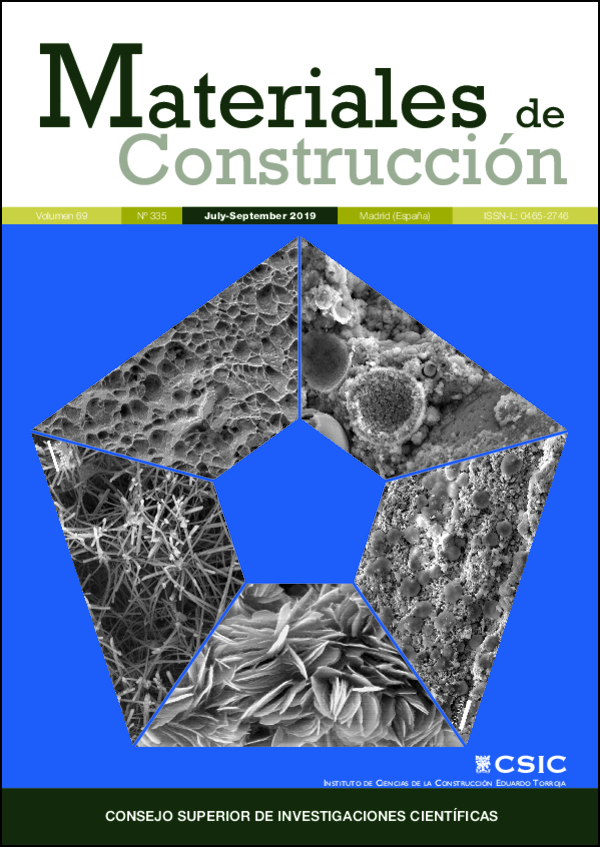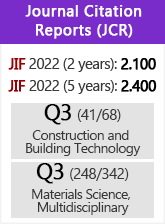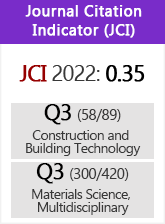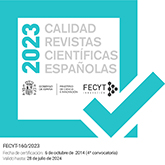Effects of Design and Construction on the Carbon Footprint of Reinforced Concrete Columns in Residential Buildings
DOI:
https://doi.org/10.3989/mc.2019.09918Keywords:
Portland cement, Concrete, Metal reinforcement, Mechanical properties, ModelizationAbstract
Constructing structural elements requires high performance materials. Important decisions about geometry and materials are made during the design and execution phases. This study analyzes and evaluates the relevant factors for reinforced concrete columns made in situ for residential buildings. This article identifies and highlights the most sensitive aspects in column design: geometry, type of cement, and concrete strength performance. Using C-40 concrete mixed with CEM-II proved to cut costs (up to 17.83%) and emissions (up to 13.59%). The ideal combination of rebar and concrete is between 1.47 and 1.73: this is the percentage of the ratio between the area of rebar and the area of the concrete section. The means used during the execution phase affect resource optimization. The location of a building has only a minor impact, wherein the wind zone exercises more influence than topographic altitude.
Downloads
References
Galán-Marín, C.; Rivera-Gómez, C.; García-Martínez, A. (2015) Embodied energy of conventional load-bearing walls versus natural stabilized earth blocks. Energy Build. 97, 146-154. https://doi.org/10.1016/j.enbuild.2015.03.054
Park, H.; Kwon B.; Shin Y.; Kim Y.; Hong T.; Choi S. (2013) Cost and CO2 Emission Optimization of Steel Reinforced Concrete Columns in High-Rise Buildings. Energies 6, 5609-5624. https://doi.org/10.3390/en6115609
Ferreiro-Cabello, J.; Fraile-Garcia, E.; Martinez de Pison Ascacibar E.; Martinez de Pison Ascacibar, F. J. (2016) Minimizing greenhouse gas emissions and costs for structures with flat slabs. J. Clean. Prod. 137, 922-930. https://doi.org/10.1016/j.jclepro.2016.07.153
Kripka, M.; Medeiros, G. F.; Fraga, J. L. T.; Marosin, P. R. (2014) Minimizing the environmental impact of R-C structural elements. Eng. Optim. 727-730. https://www. researchgate.net/publication/265597500_Minimizing_the_ environmental_impact_of_R-C_structural_elements https://doi.org/10.1201/b17488-129
Guardigli, L. (2014) Comparing the environmental impact of reinforced concrete and wooden structures. Eco-Efficient Constr. Build. Mater. 49, pp. 407-433. https://doi.org/10.1533/9780857097729.3.407
Xiao, J.; Wang, C.; Ding, T.; Akbarnezhad, A. (2018) A recycled aggregate concrete high-rise building: Structural performance and embodied carbon footprint. J. Clean. Prod. 199, 868-881. https://doi.org/10.1016/j.jclepro.2018.07.210
Zahra S.; Moussavi Nadoushani, A. A. (2015) Effects of structural system on the life cycle carbon footprint of buildings. Energy Build. 1, 337-346. https://doi.org/10.1016/j.enbuild.2015.05.044
Griffin, C. T.; Reed, B.; Hsu, S.; Cruz, P. J. S. (2010) Comparing the embodied energy of structural systems in buildings. Struct. Archit. 1367-1373. https://doi.org/10.1201/b10428-182
Martí, J. V.; García-Segura, T.; Yepes, V. (2016) Structural design of precast-prestressed concrete U-beam road bridges based on embodied energy. J. Clean. Prod. 120, 231-240. https://doi.org/10.1016/j.jclepro.2016.02.024
Fraile-Garcia, E.; Ferreiro-Cabello, J.; Martinez-Camara, E.; Jimenez-Macias, E. (2016) Optimization based on life cycle analysis for reinforced concrete structures with one-way slabs. Eng. Struct. 109, 126-138. https://doi.org/10.1016/j.engstruct.2015.12.001
Miller, S. A.; Horvath, A.; Monteiro, P. J. M.; Ostertag, C. P. (2015) Greenhouse gas emissions from concrete can be reduced by using mix proportions, geometric aspects, and age as design factors. Environ. Res. Lett. 10, 114017. https://doi.org/10.1088/1748-9326/10/11/114017
Peng, W.; Sui Pheng, L. (2011) Managing the Embodied Carbon of Precast Concrete Columns. J. Mater. Civ. Eng. 23, 1192-1199. https://doi.org/10.1061/(ASCE)MT.1943-5533.0000287
Hong, W.-K.; Park, S.-C.; Jeong, S.-Y.; Lim, G.-T.; Kim, J.-T. (2012) Evaluation of the Energy Efficiencies of Pre-cast Composite Columns. Indoor Built Environ. 21, 176-183. https://doi.org/10.1177/1420326X11420126
Wu, P.; Pienaar, J.; O'Brien, D. (2013) Developing a lean benchmarking process to monitor the carbon efficiency in precast concrete factories-a case study in Singapore. Coll. Publ. 8, 133-152. https://doi.org/10.3992/jgb.8.2.133
Wu, P. (2014) Monitoring carbon emissions in precast concrete installation through lean production - A case study in Singapore. J. Green Build. 9, 191-211. https://doi.org/10.3992/1943-4618-9.4.191
Oh, B. K.; Park, J. S.; Choi, S. W.; Park, H. S. (2016) Design model for analysis of relationships among CO2 emissions, cost, and structural parameters in green building construction with composite columns. Energy Build. 118, 301-315. https://doi.org/10.1016/j.enbuild.2016.03.015
Choi, S. W.; Oh, B. K.; Park, J. S.; Park, H. S. (2016) Sustainable design model to reduce environmental impact of building construction with composite structures. J. Clean. Prod. 137, 823-832. https://doi.org/10.1016/j.jclepro.2016.07.174
Kripka, M.; de Medeiros, G. F. (2012) Cross-Sectional Optimization of Reinforced Concrete Columns Considering both Economical and Environmental Costs. Appl. Mech. Mater. 193-194, 1086-1089. https://doi.org/10.4028/www.scientific.net/AMM.193-194.1086
Heede, P.; Van den, Maes, M.; Gruyaert, E.; Belie, N. De. (2012) Full probabilistic service life prediction and life cycle assessment of concrete with fly ash and blast-furnace slag in a submerged marine environment: a parameter study. Int. J. Environ. Sustain. Dev. 11, 32. https://doi.org/10.1504/IJESD.2012.049141
García-Segura, T.; Yepes, V.; Alcalá, J. (2014) Life cycle greenhouse gas emissions of blended cement concrete including carbonation and durability. Int. J. Life Cycle Assess. 19, 3-12. https://doi.org/10.1007/s11367-013-0614-0
Yang, K.-H.; Seo, E.-A.; Choi, D.-U. (2014) Effect of fly ash on lifecycle CO2 assessment of concrete structure. Appl. Mech. Mater. 692. https://doi.org/10.4028/www.scientific.net/AMM.692.475. https://doi.org/10.4028/www.scientific.net/AMM.692.475
Magudeaswaran, P.; Eswaramoorthi, P. (2015) Use of industrial waste materials in sustainable green high-performance reinforced concrete short columns. Int. J. Earth Sci. Eng. 8.
Albitar, M.; Mohamed Ali, M. S.; Visintin, P. (2017) Experimental study on fly ash and lead smelter slag-based geopolymer concrete columns. Constr. Build. Mater. 141, 104-112. https://doi.org/10.1016/j.conbuildmat.2017.03.014
Zhang, Y. F.; Zhao, J. H.; Cai, C. S. (2012) Seismic behavior of ring beam joints between concrete-filled twin steel tubes columns and reinforced concrete beams. Eng. Struct. 39, 1-10. https://doi.org/10.1016/j.engstruct.2012.01.014
Hirade, T.; Odajima, N.; Kimura, H.; Kaneko, H.; Yonezawa, T. (2014) Structural performance of the steel-bar-reinforced concrete-filled circular thin steel tubular columns using high slag cement. J. Struct. Constr. Eng. (Transactions AIJ) 79, 651-660. https://doi.org/10.3130/aijs.79.651
AENOR GlobalEPD Program. Environmental Product Declaration Long steel laminate construction unalloyed hot oven from: corrugated bars. 1-12 (2014).
AENOR GlobalEPD Program. Environmental Product Declaration Cement CEM I. 1-12 (2014).
AENOR GlobalEPD Program. Environmental Product Declaration Cement CEM II. 1-12 (2014).
AENOR GlobalEPD Program. Environmental Product Declaration Cement CEM III. 1-12 (2014).
AENOR GlobalEPD Program. Environmental Product Declaration Cement CEM IV. 1-12 (2014).
AENOR GlobalEPD Program. Environmental Product Declaration Cement CEM V. 1-12 (2014).
Fraile-Garcia, E.; Ferreiro-Cabello, J.; Martinez-Camara, E.; Jimenez-Macias, E. (2015) Adaptation of methodology to select structural alternatives of one-way slab in residential building to the guidelines of the European Committee for Standardization (CEN/TC 350). Environ. Impact Assess. Rev. 55, 144-155. https://doi.org/10.1016/j.eiar.2015.08.004
Yang, K. H.; Jung, Y. B.; Cho, M. S.; Tae, S. H. (2015) Effect of Supplementary Cementitious Materials on Reduction of CO2 Emissions From Concrete. Handb. Low Carbon Concr. 103, 774-783. https://doi.org/10.1016/j.jclepro.2014.03.018
Park, H. S.; Lee, H.; Kim, Y.; Hong, T.; Choi, S. W. (2014) Evaluation of the influence of design factors on the CO2 emissions and costs of reinforced concrete columns. Energy Build. 82, 378-384. https://doi.org/10.1016/j.enbuild.2014.07.038
Jeong, J.; Taehoon H.; Changyoon J.; Jimin K.; Minhyun L.; Kwangbok J.; Seunghwan L. (2017) An integrated evaluation of productivity, cost and CO2 emission between prefabricated and conventional columns. J. Clean. Prod. 142, 2393-2406. https://doi.org/10.1016/j.jclepro.2016.11.035
Li, H.; Deng, Q.; Xia, B.; Zhang, J.; Skitmore, M. (2019) Assessing the life cycle CO2 emissions of reinforced concrete structures: Four cases from China. J. Clean. Prod. 210, 1496-1506. https://doi.org/10.1016/j.jclepro.2018.11.102
Plataforma Tecnologica Española del Hormigón. Hormigón: Un Material Para Aumentar la Sotenibilidad de la Construcción. PTEH (2014). Available at: https://www.ieca.es/publicaciones/. (Accessed: 1st December 2017).
CYPE Ingenieros S.A. CYPE Ingenieros S.A. Software for Architecture, Engineering and Construction. Spain, 2016. (2017).
Ministry of Public Works Spain. Code on Structural Concrete (Spanish abbreviation - EHE-08). (2008).
Published
How to Cite
Issue
Section
License
Copyright (c) 2019 Consejo Superior de Investigaciones Científicas (CSIC)

This work is licensed under a Creative Commons Attribution 4.0 International License.
© CSIC. Manuscripts published in both the printed and online versions of this Journal are the property of Consejo Superior de Investigaciones Científicas, and quoting this source is a requirement for any partial or full reproduction.All contents of this electronic edition, except where otherwise noted, are distributed under a “Creative Commons Attribution 4.0 International” (CC BY 4.0) License. You may read here the basic information and the legal text of the license. The indication of the CC BY 4.0 License must be expressly stated in this way when necessary.
Self-archiving in repositories, personal webpages or similar, of any version other than the published by the Editor, is not allowed.


















